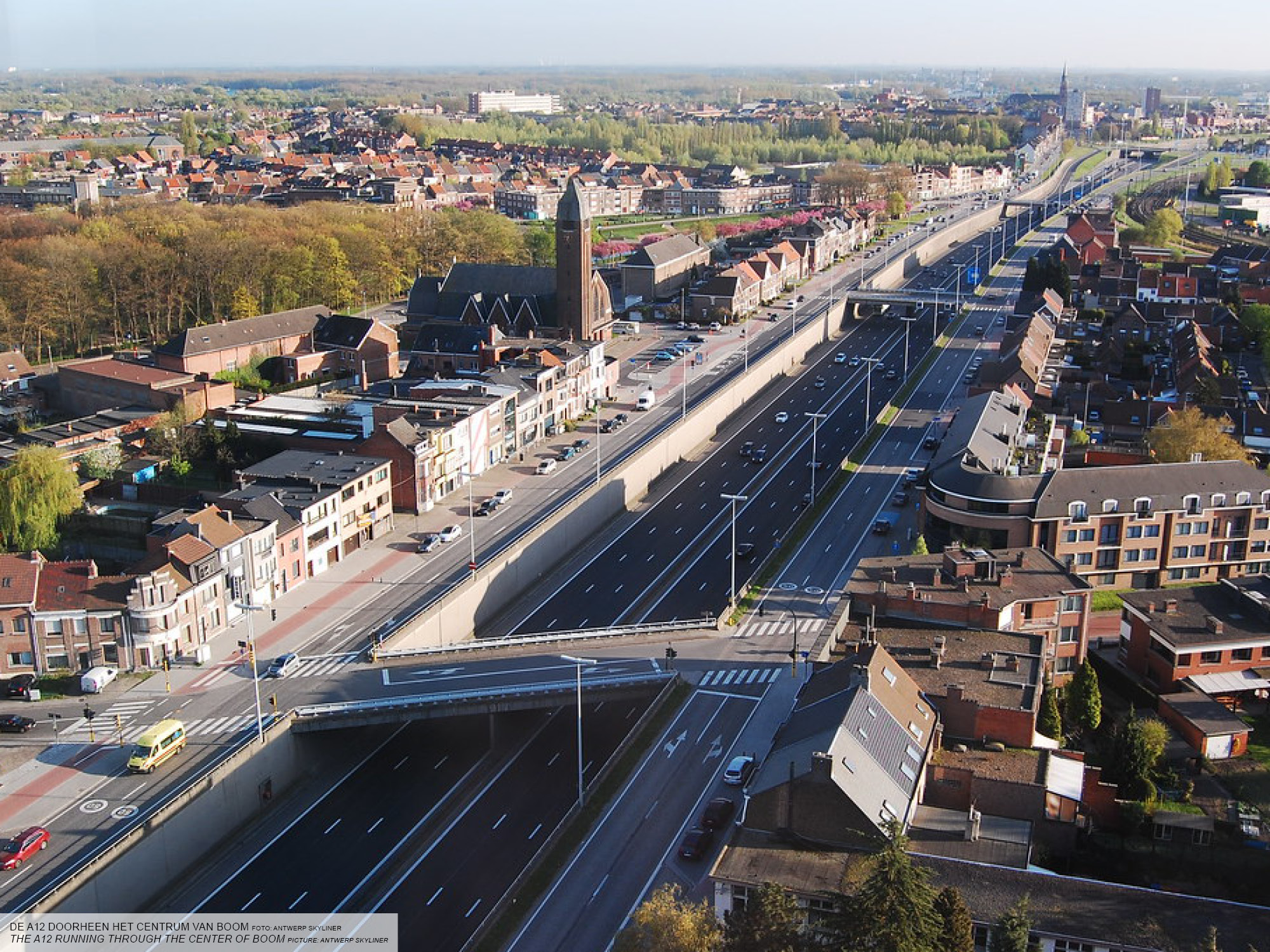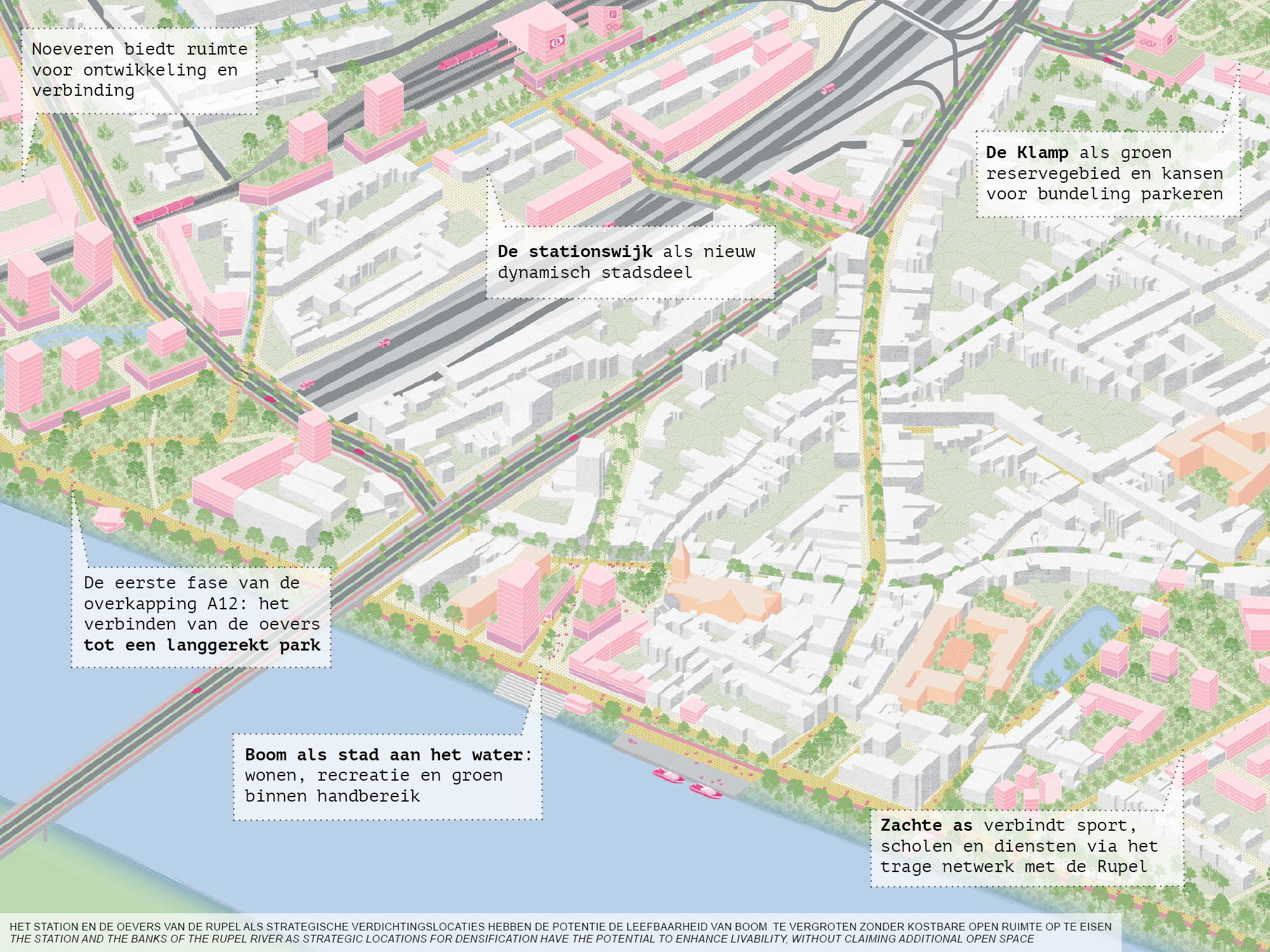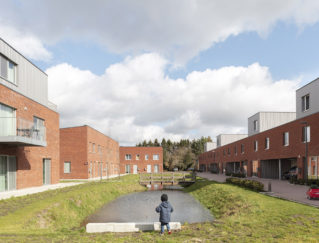Flanders’ is characterized by scattered spatial policy that has resulted in great loss of energy, biodiversity, time, money and space.
The ‘Bouwmeesterscan’ is a tool to help signal weaknesses and opportunities in spatial policy for local governments, and translates these into a concrete agenda of projects and policy changes for the transition towards a healthy and sustainable living environment. Spatial decisions are connected to challenges such as the energy transition, the mobility shift healthy urban environments and a balance between ecology and productive open space.
Boom is a Flemish municipality south of Antwerp and part of the Rupel region, where clay quarries and brick production have determined the landscape. Clay pits now serve as nature of recreational area’s, but the small workershouses along the edges have not been designed for this change in function. New developments threaten the open space in the already very dense municipality, without generating new qualities for its inhabitants. Located inbetween Antwerp and Brussels, Boom is crossed by big infrastructures, offering little to the city, but seriously damaging its structure.
The fased covering of the A12 will bring space to breathe in the city and repair severed connections. The existing natural structures need to be used to improve livability and natural value and make the city an attractive place to reside. New developments will function as a strategic lever, used for the realization of these qualities.
The full report can be found on the website of the Flemish Bouwmeester: vlaamsbouwmeester.be
Status: Study 2019
Team: Johan de Wachter, Joris van Arkel, Anna-Dobrawa Kicińska
Collaboration: PosadMaxwan, Generation.Energy, VE-R, Deltares
Client: Team Vlaamse Bouwmeester, Municipality Boom
Location: Boom, Antwerpen, BE












Flanders’ is characterized by scattered spatial policy that has resulted in great loss of energy, biodiversity, time, money and space.
The ‘Bouwmeesterscan’ is a tool to help signal weaknesses and opportunities in spatial policy for local governments, and translates these into a concrete agenda of projects and policy changes for the transition towards a healthy and sustainable living environment. Spatial decisions are connected to challenges such as the energy transition, the mobility shift healthy urban environments and a balance between ecology and productive open space.
Boom is a Flemish municipality south of Antwerp and part of the Rupel region, where clay quarries and brick production have determined the landscape. Clay pits now serve as nature of recreational area’s, but the small workershouses along the edges have not been designed for this change in function. New developments threaten the open space in the already very dense municipality, without generating new qualities for its inhabitants. Located inbetween Antwerp and Brussels, Boom is crossed by big infrastructures, offering little to the city, but seriously damaging its structure.
The fased covering of the A12 will bring space to breathe in the city and repair severed connections. The existing natural structures need to be used to improve livability and natural value and make the city an attractive place to reside. New developments will function as a strategic lever, used for the realization of these qualities.
The full report can be found on the website of the Flemish Bouwmeester: vlaamsbouwmeester.be
Status: Study 2019
Team: Johan de Wachter, Joris van Arkel, Anna-Dobrawa Kicińska
Collaboration: PosadMaxwan, Generation.Energy, VE-R, Deltares
Client: Team Vlaamse Bouwmeester, Municipality Boom
Location: Boom, Antwerpen, BE
Flanders’ is characterized by scattered spatial policy that has resulted in great loss of energy, biodiversity, time, money and space.
The ‘Bouwmeesterscan’ is a tool to help signal weaknesses and opportunities in spatial policy for local governments, and translates these into a concrete agenda of projects and policy changes for the transition towards a healthy and sustainable living environment. Spatial decisions are connected to challenges such as the energy transition, the mobility shift healthy urban environments and a balance between ecology and productive open space.
Boom is a Flemish municipality south of Antwerp and part of the Rupel region, where clay quarries and brick production have determined the landscape. Clay pits now serve as nature of recreational area’s, but the small workershouses along the edges have not been designed for this change in function. New developments threaten the open space in the already very dense municipality, without generating new qualities for its inhabitants. Located inbetween Antwerp and Brussels, Boom is crossed by big infrastructures, offering little to the city, but seriously damaging its structure.
The fased covering of the A12 will bring space to breathe in the city and repair severed connections. The existing natural structures need to be used to improve livability and natural value and make the city an attractive place to reside. New developments will function as a strategic lever, used for the realization of these qualities.
The full report can be found on the website of the Flemish Bouwmeester: vlaamsbouwmeester.be
Status: Study 2019
Team: Johan de Wachter, Joris van Arkel, Anna-Dobrawa Kicińska
Collaboration: PosadMaxwan, Generation.Energy, VE-R, Deltares
Client: Team Vlaamse Bouwmeester, Municipality Boom
Location: Boom, Antwerpen, BE




